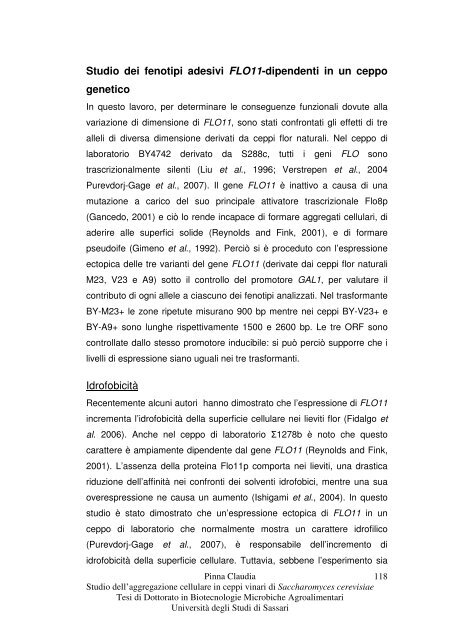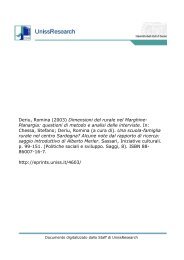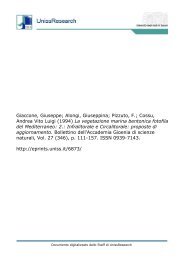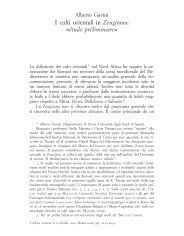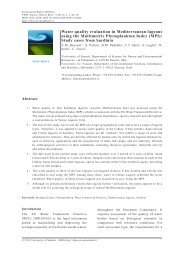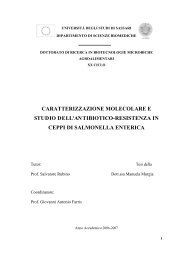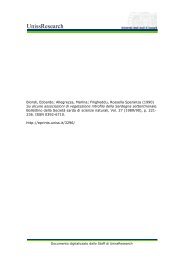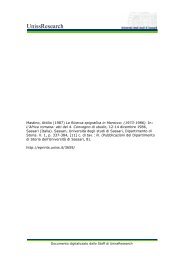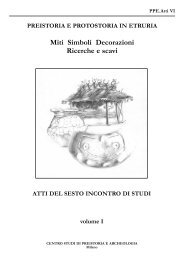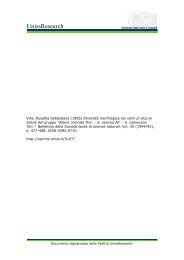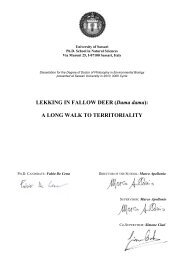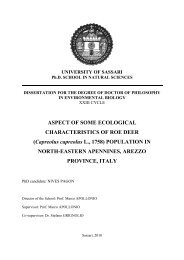Studio dell'aggregazione cellulare in ceppi vinari di Saccharomyces ...
Studio dell'aggregazione cellulare in ceppi vinari di Saccharomyces ...
Studio dell'aggregazione cellulare in ceppi vinari di Saccharomyces ...
You also want an ePaper? Increase the reach of your titles
YUMPU automatically turns print PDFs into web optimized ePapers that Google loves.
<strong>Stu<strong>di</strong>o</strong> dei fenotipi adesivi FLO11-<strong>di</strong>pendenti <strong>in</strong> un ceppo<br />
genetico<br />
In questo lavoro, per determ<strong>in</strong>are le conseguenze funzionali dovute alla<br />
variazione <strong>di</strong> <strong>di</strong>mensione <strong>di</strong> FLO11, sono stati confrontati gli effetti <strong>di</strong> tre<br />
alleli <strong>di</strong> <strong>di</strong>versa <strong>di</strong>mensione derivati da <strong>ceppi</strong> flor naturali. Nel ceppo <strong>di</strong><br />
laboratorio BY4742 derivato da S288c, tutti i geni FLO sono<br />
trascrizionalmente silenti (Liu et al., 1996; Verstrepen et al., 2004<br />
Purevdorj-Gage et al., 2007). Il gene FLO11 è <strong>in</strong>attivo a causa <strong>di</strong> una<br />
mutazione a carico del suo pr<strong>in</strong>cipale attivatore trascrizionale Flo8p<br />
(Gancedo, 2001) e ciò lo rende <strong>in</strong>capace <strong>di</strong> formare aggregati cellulari, <strong>di</strong><br />
aderire alle superfici solide (Reynolds and F<strong>in</strong>k, 2001), e <strong>di</strong> formare<br />
pseudoife (Gimeno et al., 1992). Perciò si è proceduto con l’espressione<br />
ectopica delle tre varianti del gene FLO11 (derivate dai <strong>ceppi</strong> flor naturali<br />
M23, V23 e A9) sotto il controllo del promotore GAL1, per valutare il<br />
contributo <strong>di</strong> ogni allele a ciascuno dei fenotipi analizzati. Nel trasformante<br />
BY-M23+ le zone ripetute misurano 900 bp mentre nei <strong>ceppi</strong> BY-V23+ e<br />
BY-A9+ sono lunghe rispettivamente 1500 e 2600 bp. Le tre ORF sono<br />
controllate dallo stesso promotore <strong>in</strong>ducibile: si può perciò supporre che i<br />
livelli <strong>di</strong> espressione siano uguali nei tre trasformanti.<br />
Idrofobicità<br />
Recentemente alcuni autori hanno <strong>di</strong>mostrato che l’espressione <strong>di</strong> FLO11<br />
<strong>in</strong>crementa l’idrofobicità della superficie <strong>cellulare</strong> nei lieviti flor (Fidalgo et<br />
al. 2006). Anche nel ceppo <strong>di</strong> laboratorio Σ1278b è noto che questo<br />
carattere è ampiamente <strong>di</strong>pendente dal gene FLO11 (Reynolds and F<strong>in</strong>k,<br />
2001). L’assenza della prote<strong>in</strong>a Flo11p comporta nei lieviti, una drastica<br />
riduzione dell’aff<strong>in</strong>ità nei confronti dei solventi idrofobici, mentre una sua<br />
overespressione ne causa un aumento (Ishigami et al., 2004). In questo<br />
stu<strong>di</strong>o è stato <strong>di</strong>mostrato che un’espressione ectopica <strong>di</strong> FLO11 <strong>in</strong> un<br />
ceppo <strong>di</strong> laboratorio che normalmente mostra un carattere idrofilico<br />
(Purevdorj-Gage et al., 2007), è responsabile dell’<strong>in</strong>cremento <strong>di</strong><br />
idrofobicità della superficie <strong>cellulare</strong>. Tuttavia, sebbene l’esperimento sia<br />
P<strong>in</strong>na Clau<strong>di</strong>a<br />
118<br />
<strong>Stu<strong>di</strong>o</strong> dell’aggregazione <strong>cellulare</strong> <strong>in</strong> <strong>ceppi</strong> v<strong>in</strong>ari <strong>di</strong> <strong>Saccharomyces</strong> cerevisiae<br />
Tesi <strong>di</strong> Dottorato <strong>in</strong> Biotecnologie Microbiche Agroalimentari<br />
Università degli Stu<strong>di</strong> <strong>di</strong> Sassari


